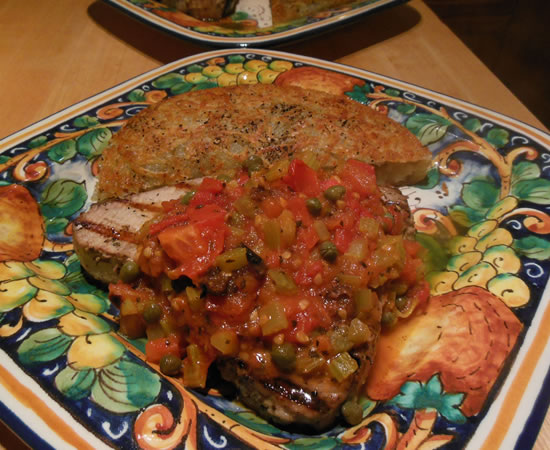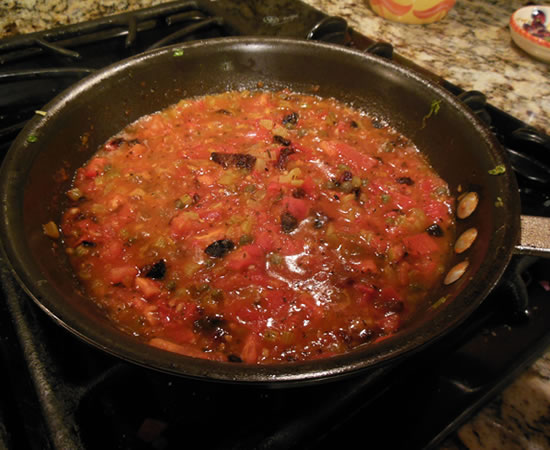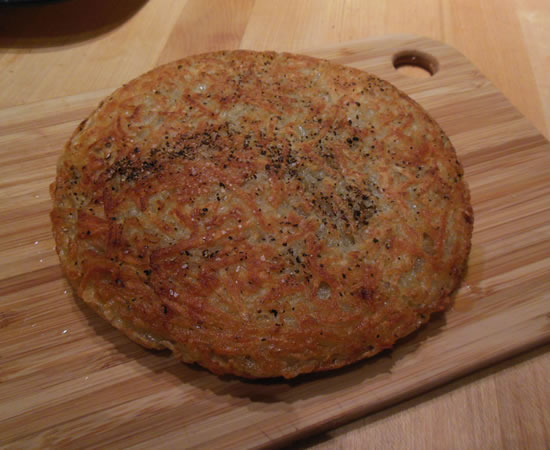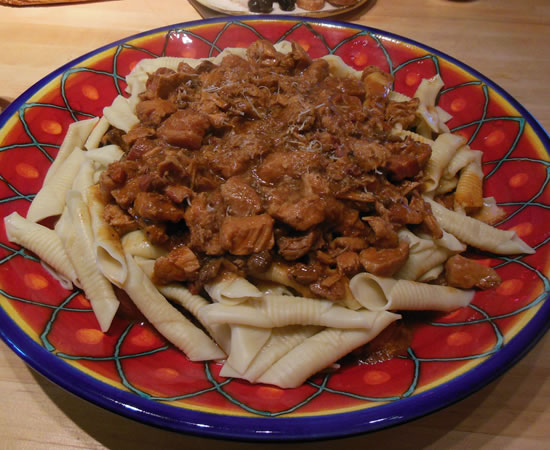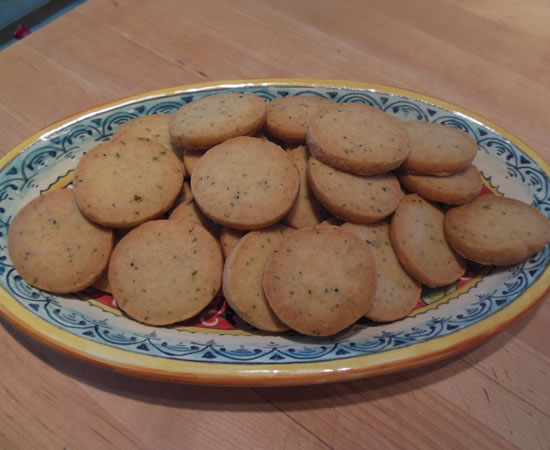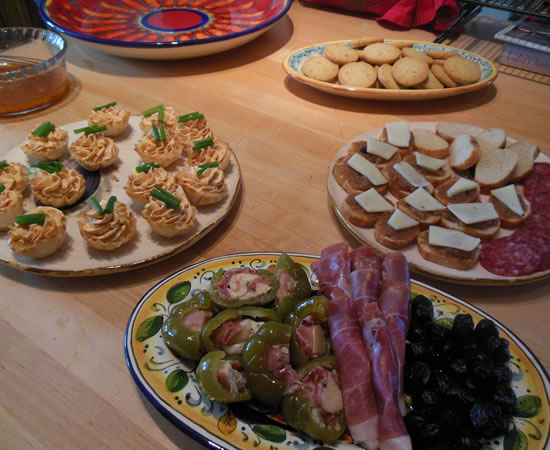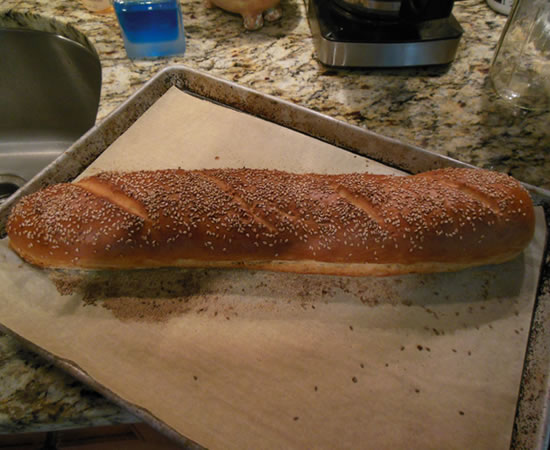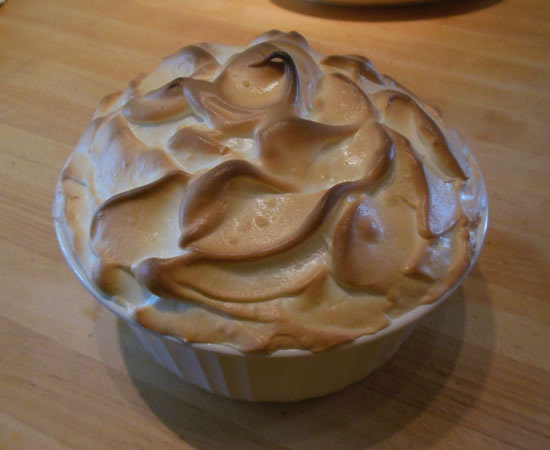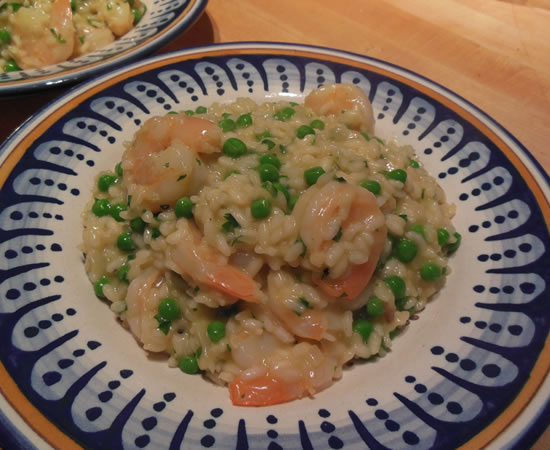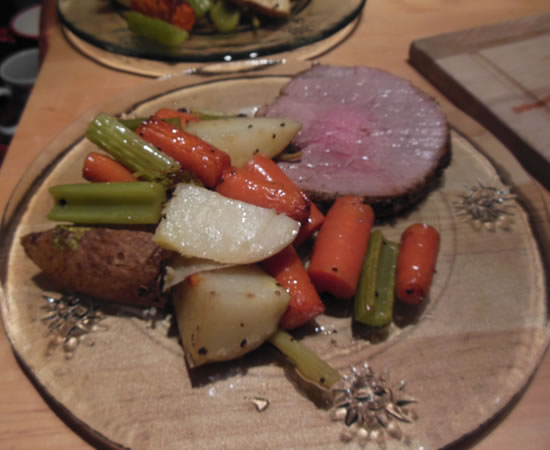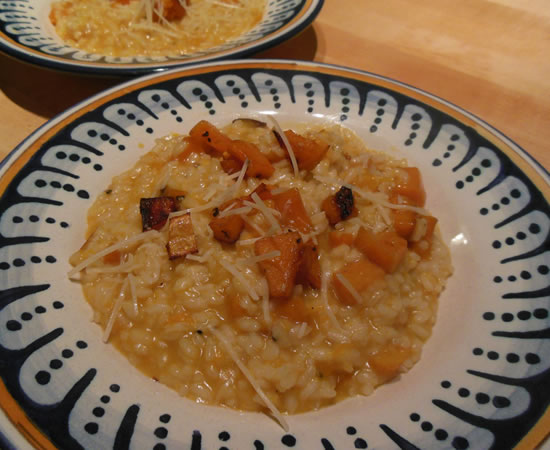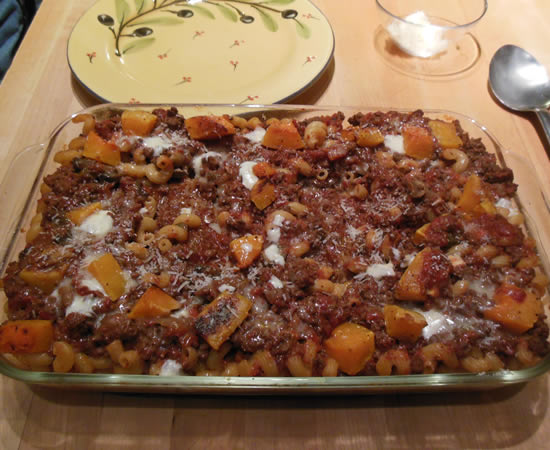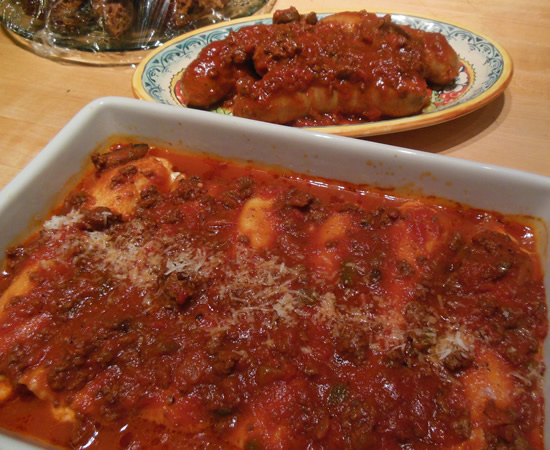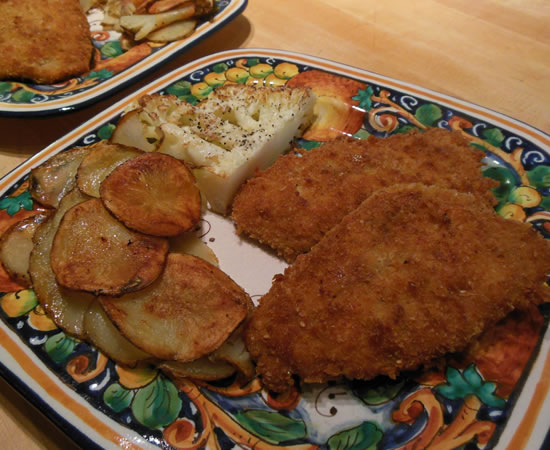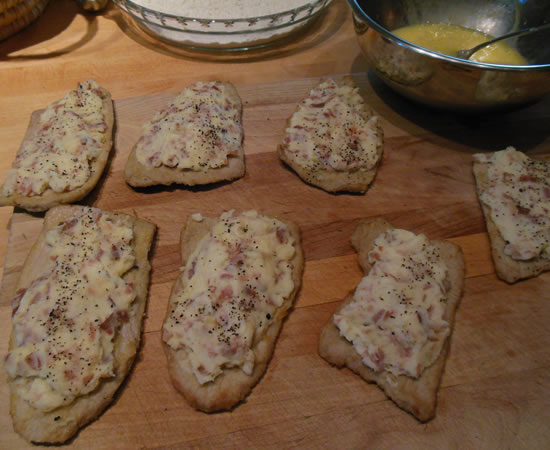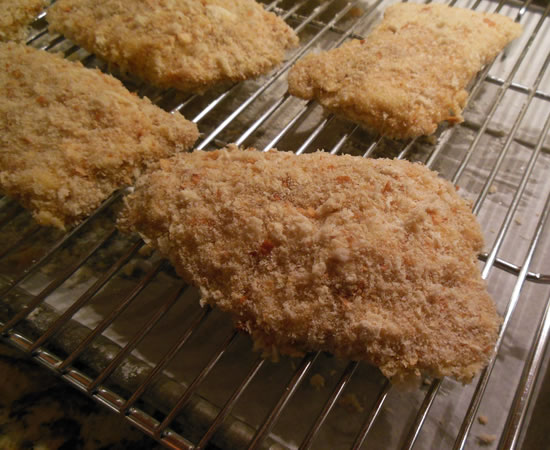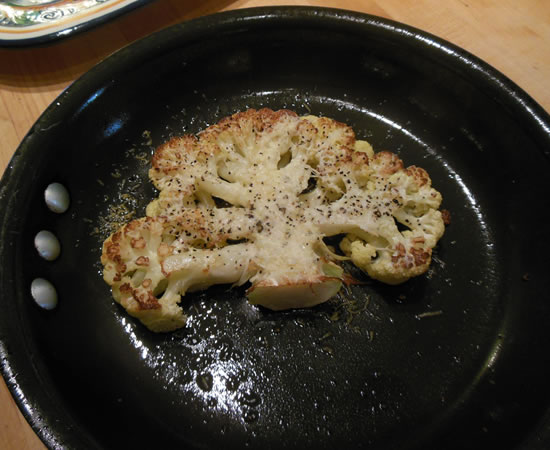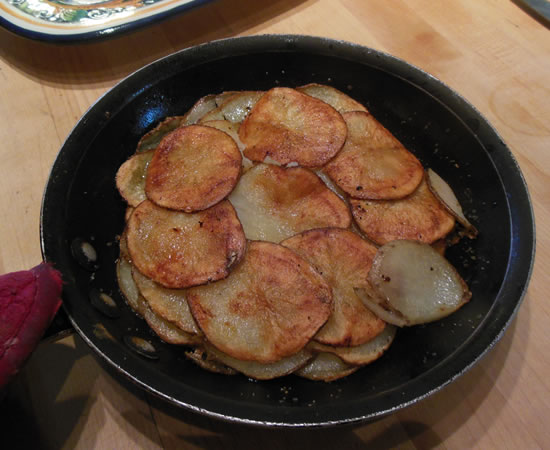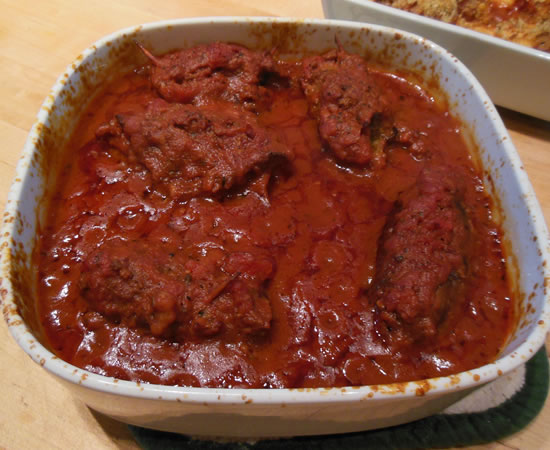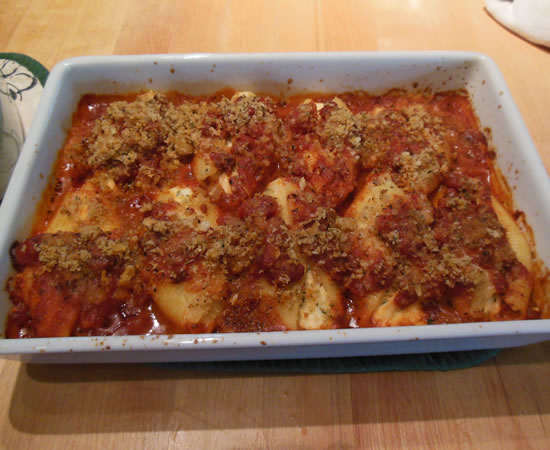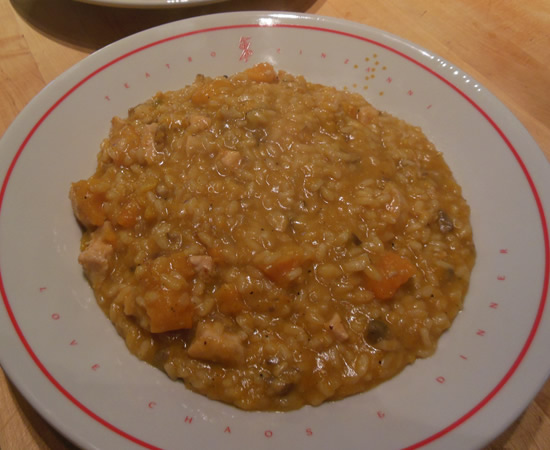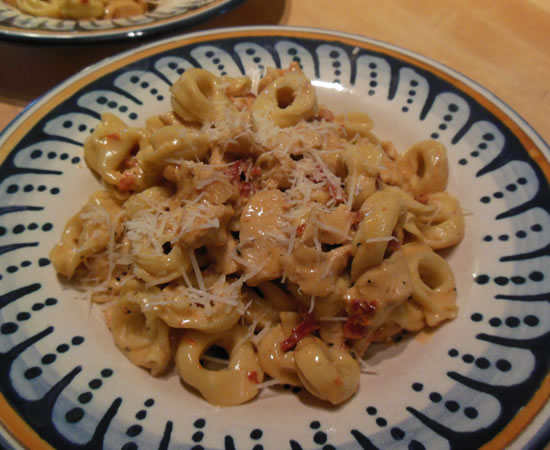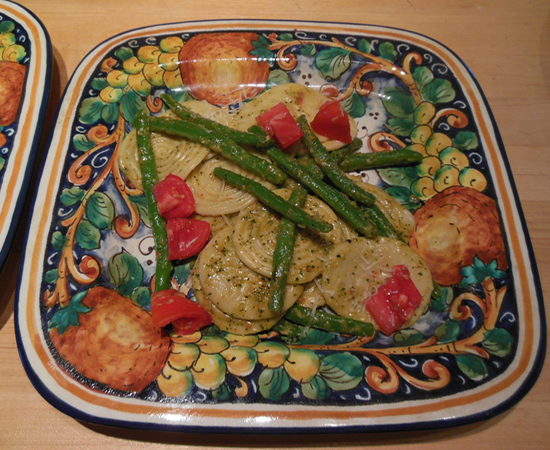Sicilian Tuna & Eggplant Potatoes
I am not an intuitive seafood cook. I can do the basics, but I never really learned fish. None of the restaurants where I cooked did a lot of fish - except the annual Cioppino Fest at The Riviera - and that doesn't count. So if I want to do something other than a pan-fry, I need inspiration.
I found it today in an old Gourmet. A recipe called "Sicilian Tuna."
With a name like that, I figured it had to be good. And since we're going there next year for our 20th anniversary, I thought I may as well start getting used to the cuisine. I do like to plan, after all...
The recipe calls for a marinade and a sauce, both of which were easy to put together and were really, really flavorful. We both did a lot of oooh's and aaah's over this one.
And the potatoes... they totally rocked the Casbah! Who knew stuffing shredded potatoes with eggplant would be so good?!?
Sicilian Tuna
adapted from Gourmet
For tuna:
- 2 tablespoons olive oil
- 2 tablespoons fresh lemon juice
- 3 anchovy fillets, finely chopped
- 1 garlic clove, finely chopped
- 2 teaspoons finely chopped oregano
- tuna steaks
For sauce:
- 2 tablespoons extra-virgin olive oil
- 2 celery ribs, cut into 1/4-inch dice
- 2 ripe tomatoes, cut into 1/4-inch dice
- 1/4 cup Kalamata or other brine-cured black olives, pitted and coarsely chopped
- 2 tablespoons small capers, drained and chopped
- 3 tablespoons finely chopped basil
- 1 tablespoons fresh lemon juice
Marinate tuna:
Combine oil, lemon juice, anchovies, garlic, oregano, and tuna in a large sealable bag and seal bag, pressing out excess air. Let stand at room temperature, turning occasionally, 30 minutes.Grill tuna:
Remove tuna from marinade and shake off any excess. Grill tuna, turning once, until pale pink in center, 5 to 7 minutes. Transfer to a platter and cover with foil to keep warm.Meanwhile, make sauce:
Heat oil in a 12-inch heavy skillet over medium-high heat until it shimmers. Add diced celery and cook, stirring, until tender, about 5 minutes. Stir in tomatoes, olives, and capers and cook until sauce is slightly thickened, about 5 minutes.
Stir in basil, lemon juice, and 1/4 teaspoon each of salt and pepper and remove from heat. Spoon sauce over tuna.
It definitely did what it was supposed to do.
The other hit of the evening was the potato and eggplant dish.
This recipe came from Bon Appetit. I cut it in half for the two of us.
Crispy Potato Eggplant
- 2 1/2 cups finely diced, peeled eggplant
- 1 teaspoon coarse salt plus more to taste
- olive oil
- 3 tablespoons minced shallots
- 4 large Idaho potatoes
- Pepper
- 1/4 cup (1/2 stick) unsalted butter
Place eggplant in a nonreactive bowl. Toss with 1 teaspoon of salt and allow to sit for 20 minutes. Remove to a clean kitchen towel and tightly twist to squeeze out all moisture. Set aside.
Heat 2 tablespoons of oil in a medium sauté pan over medium heat. Add the eggplant and shallots and sauté for about 6 minutes, or until very tender. Remove from heat and set aside.
Peel potatoes. Using a hand grater or mandoline, shred potatoes into a clean kitchen towel. Tightly twist to squeeze out as much moisture as possible.
Preheat oven to 375°F.
Heat remaining 1/4 cup of oil in a 9-inch ovenproof, nonstick sauté pan over medium heat. Using a spatula, evenly press half of the potatoes into the pan. Season to taste with salt and pepper. Spread the reserved eggplant over the top. Pat remaining potatoes evenly over the eggplant. Again, season to taste with salt and pepper. Cook for about 10 minutes, or until bottom is golden. Carefully turn and dab the crust with bits of butter. Cook for about 5 minutes, or until bottom begins to crisp. Place in the preheated oven and bake for 25 minutes, or until potatoes are cooked and tart is golden and crisp. Remove from oven and allow to rest for 5 minutes. Using a sharp serrated knife, cut into 6 wedges and serve immediately.
The potatoes really did rock! It was a really unique flavor and a fun presentation.
You really need to wring as much liquid from the eggplant and the potatoes as you possibly can. They cannot be too dry for this.
I can see this being made, again...
Garganelli con Maiale in Guazetto
Our biannual dinner with Linda and David was a rousing success!
It's fun kinda going over the top now and again - and not easy cooking for a mere four people! My instincts are to make massive amounts of food for massive amounts of people. This turns into massive amounts of food for a mere four people.
We decided early on that we were going to do a strictly-Italian dinner because, well... we had to show off our fabulous hand-painted Italian dinnerware we had made for us on our recent trip to Italy. Yes. It is fun being insufferable now and again...
We also decided we would do a hand-made pasta because Victor has the pasta-making down to a science. He just flat-out makes fabulous pasta.
The sauce was to be a pheasant recipe from Lidia we made many times back in California when our next door neighbor would show up on our doorstep with pheasants he had just shot.
Damn, they were good.
Alas, it's not as easy to find pheasant here in suburbia. I actually ordered one from the local Wegmans and when I went to pick it up on Wednesday, it was really small and really expensive. I would have needed at least two of them for dinner and I just couldn't justify spending $30.00 each for them. They were very nice when I said "no thanks."
I came home empty-handed and Victor suggested pork. Brilliant, as we not only had cubed pork in the freezer, we also had a chunk of wild boar ventrèche. Ventrèche is marbled pork belly with a firm texture, similar to pancetta. It's rich, salty and very porky - the perfect addition to a dish that should have a bit of a gamy edge to it. Crisis averted and a new dish was born.
I made the sauce yesterday because it is definitely the type of dish that improves with an overnight stay in the 'fridge.
Garganelli con Maiale in Guazetto
- ½ cup dried porcini mushrooms
- 4 whole cloves
- 2 bay leaves
- 1 sprig fresh rosemary
- ¼ cup extra-virgin olive oil
- 2 1/2 lbs cubed pork
- freshly ground black pepper
- ½ cup chicken liver, trimmed and finely chopped
- 3 medium onions, chopped
- 8 oz ventrèche, thick-sliced
- 1 cup dry white wine
- 3 tablespoons tomato paste, plus 2 teaspoons
- 4 cups beef broth
- ½ cup Parmigiano-Reggiano, freshly grated, plus more for serving
Garganelli, made from basic egg pasta dough
Soak the porcini in 2 cups of warm water until softened, about 30 minutes. Drain the porcini, reserving the liquid. Rinse the mushrooms and chop them coarsely, discarding any tough bits. Strain the soaking liquid through a sieve lined with cheesecloth. Set the liquid and chopped mushrooms aside. Tie the cloves, bay leaves, and rosemary securely in a small square of cheesecloth.
In a large casserole heat the oil over high heat. Add the pork pieces and sprinkle lightly with salt and pepper. Cook until lightly browned, about 10 minutes. Remove the pork pieces.
Add the onions to the casserole, season them lightly with salt and pepper and cook until golden, about 5 minutes. Add the chicken livers and cook them, turning as necessary, until browned, about 4 minutes. Add the chopped porcini and cook, stirring, until they are dry, about 5 minutes. Add the wine and cook, stirring, until nearly evaporated, about 4 minutes. Stir in the tomato paste until the vegetables are coated. Add the reserved porcini liquid and about 1/2 cup of the beef broth and bring to a boil. Return the pork pieces to the pan and tuck the cheesecloth packet into the liquid. Cover the casserole partially and simmer gently until the liquid is reduced by about half, about 15 minutes. Continue simmering, adding beef broth 1/2 cup at a time and waiting until the liquid is reduced by half before adding more, until the pork is tender and the liquid is velvety, about 1 hour. Remove and discard the cheesecloth packet. Remove the meat and shred it coarsely. Return it to the sauce and reheat before serving.
And while I was at work, yesterday, Victor made the pasta.
Every one of those little buggers was cut and rolled by hand. This is where Victor excels over me. I do not have nearly the patience necessary to make this. The pasta is hand-made and rolled, then cut into squares, rolled around a little stick - Victor used a chop stick - and then rolled down a grooved board.
Each one.
Individually.
His pasta is excellent. Every time. I see no need to even try at this point.
Garganelli
- 3 cups "00" Italian flour - or all-purpose flour
- 4 large eggs
- ½ teaspoon salt
- 1 teaspoon extra-virgin olive oil
- warm water as needed
Place 3 cups of flour in a mound on a wooden surface, Make a well in the center of the mound. Beat the eggs, olive oil and salt together in a small bowl. Pour them into the well. With your finger, slowly incorporate the flour into the eggs until it is mixed.
Knead the remaining flour into the dough until a rough and slightly sticky dough is formed.
Knead the dough by gathering it into a compact ball, then pushing the ball away from you with the heels of your hands. Repeat the gathering and pushing motion several times, then press into the dough, first with the knuckles of one hand, then with the other, several times. Alternate between kneading and 'knuckling' the dough until it is smooth, silky and elastic-it pulls back into shape when you stretch it. The process will take about 10 minutes of constant kneading. Flour the work surface and your hands lightly any time the dough begins to stick while you're kneading.
Roll the dough into a smooth ball and place in a small bowl. Cover with plastic wrap. Let the dough rest at least one hour at room temperature, or up to 1 day in the refrigerator before rolling and shaping the pasta. If the dough has been refrigerated, let it stand at room temperature for about an hour before rolling and shaping.
To shape garganelli:
Run pasta through a pasta roller to about the second-thinnest setting. Cut into squares about 1-1 1/2". moisten one corner with a bit of water or egg and, from the opposite corner, roll around a wooden spoon handle or chopstick. Roll pasta down a grooved gnocchi board, pressing to create ridges and seal each piece of pasta.
Cook in boiling salted water about 6 minutes.
We had to start off with a few appetizers, of course. My first thought was to have an all-Italian cheese plate with some breads and crackers. Then I decided to make some crackers. Ina Garten has a great recipe for a cheese and thyme cracker - so off I went.
Parmesan Thyme Crackers
adapted from Ina Garten
- 1 cube unsalted butter, at room temperature
- 4 ounces freshly grated Parmesan cheese (about 1 cup)
- 1 teaspoon minced fresh thyme leaves
- 1/2 teaspoon kosher salt
- 1/2 teaspoon freshly ground black pepper
- 1 1/4 cups all-purpose flour
Cream the butter in mixer fitted with paddle attachment for 1 minute. Slowly add the Parmesan, thyme, salt, and pepper and mix well. With the mixer still on low, add the flour and combine until the mixture is in large crumbles, about 1 minute. If the dough is too dry, add 1 teaspoon water.
Dump the dough onto a floured board, press it into a ball, and roll into a 9-inch log. Wrap in plastic and refrigerate for at least 30 minutes or for up to 4 days.
Meanwhile, preheat the oven to 350°. Cut the log into 3/8-inch-thick rounds with a small, sharp knife and place them on a sheet pan lined with parchment paper. Bake for 22 minutes, until very lightly browned. Cool and serve at room temperature.
The crackers came out so good I decided adding cheese with them was overkill.
And then there was fig and onion on baguette with Italian truffle cheese, roasted red pepper cream cheese in filo cups, hot pepper shooters, prosciutto, salami, oil-cured olives, and a hot hors d'oeuvre made with thinly-rolled bread dough topped with salami, sauteed fennel, and gorgonzola cheese, and then topped with another thin sheet of dough and baked at 400° for about 15 minutes. Alas, I didn't get a picture of it.
Fresh-baked bread, of course. I made a batch of James Beard's Continental Bread.
James Beard French-Style Bread
- 1 package active dry yeast
- 2 tsp sugar
- 2 cups warm water (100° to 115°, approximately)
- 2 tsp salt
- 5 cups bread flour
- 3 tablespoons yellow cornmeal
- 1 egg white, mixed with 1 tablespoon cold water
- sesame seeds
Directions
Combine the yeast with sugar and warm water in a large bowl and allow to proof. Mix the salt with the flour and add to the yeast mixture, a cup at a time, until you have a stiff dough. Remove to a lightly floured board and knead until no longer sticky, about 10 minutes, adding flour as necessary. Place in a buttered bowl and turn to coat the surface with butter. Cover and let rise in a warm place until doubled in bulk, 1½ to 2 hours.
Punch down the dough. Turn out on a floured board and shape into long, French bread-style loaves. Place on a baking sheet that has been sprinkled with the cornmeal but not buttered. Slash the tops of the loaves diagonally in two or three places, and brush with the egg wash and sprinkle with sesame seeds. Place in a cold oven, set the temperature at 400°, and bake 35 minutes, or until well browned and hollow sounding when the top is rapped.
I actually just made one loaf and used the rest of the dough for the appetizer.
And then we had dessert...
Zuppa Inglese. It translates to "English Soup." We first had it at a great restaurant in Florence. I've now made it twice and this time was the best. I think I finally have it down.
Zuppa Inglese
Sponge cake:
- 2 tbsp unsalted butter, melted
- 1 cup sifted cake flour
- 1/2 cup sugar
- 1/8 tsp salt
- 4 large eggs, at room temperature
- 1 tsp pure vanilla extract
Pour the melted butter into a 1-quart bowl; reserve. Return the sifted flour to the sifter or sieve and add 1 tbsp of the sugar and the salt; sift onto a piece of waxed paper and set aside.
Put the eggs and the remaining sugar into the bowl of a heavy-duty mixer (or work with a hand-held mixer). Holding the whisk attachment from the mixer in your hand, beat the mixture to blend the ingredients. With the bowl and whisk attachment in place, whip the mixture on medium speed until it is airy, pale, and tripled in volume, like softly whipped cream, 4 to 5 minutes. You’ll know that the eggs are properly whipped when you lift the whisk and the mixture falls back into the bowl in a ribbon that rests on the surface for about 10 seconds. If the ribbon immediately sinks into the mixture, continue whipping for a few more minutes. Pour in the vanilla extract during the last moments of whipping.
Detach the bowl from the mixer. Sprinkle about one third of the sifted flour mixture over the batter. Fold in the flour with a rubber spatula, stopping as soon as the flour is incorporated. Fold in the rest of the flour in 2 more additions.
Gently spoon about 1 cup of the batter into the bowl with the melted butter and fold the butter in with the rubber spatula. Fold this mixture into the batter in the mixer bowl. (This is the point at which the batter is at its most fragile, so fold gingerly.) The batter should be poured into a prepared pan and baked immediately.
Bake at 350° about 25-27 minutes or until cake springs back when lightly touched and just begins to pull away from the sides of the pan.
Cool in pan about 10 minutes then remove, cooling right-side up on cooling rack.
Sugar Syrup:
- 1 cup sugar
- 1 cup water
- 2 tbsp limoncello
Mix ingredients. Bring to boil in small saucepan and boil about 1 minute. Cool and set aside.
Pastry Cream
- 2 cups whole milk
- Grated zest of 1 lemon
- 1 egg
- 2 egg yolks
- ⅓ cup sugar
- ⅓ cup unbleached all-purpose flour
- 1 teaspoon vanilla extract
Bring the milk and lemon zest to just below the boiling point; remove from the heat. In a medium bowl, beat the egg, egg yolks, and sugar until creamy. Add the flour and vanilla as you beat with a whisk, then slowly beat in the hot milk, still whisking. Pour the mixture into the pot in which you heated the milk. Cook over medium heat, stirring, until thick, about 5 minutes. Transfer to a bowl, cover, and refrigerate 2 hours.
Meringue
- 4 egg whites
- 1/2 cup sugar
Whip egg whites. Slowly add sugar and continue whipping until firm peaks are formed.
To assemble
Slice cake horizontally into three layers. Cut to snugly fit bottom of baking dish. Liberally douse with sugar syrup. Cover with half the pastry cream. Place second layer of cake on top, press down, again liberally douse with sugar syrup and the rest of the pastry cream. Top with final layer of cake.
Completely seal top of dish with meringue. Place in 450° oven about 5 minutes to brown meringue.
Serve at room temperature.
It's just spooned out onto the plate. It doesn't necessarily make the most fabulous presentation, but no one notices after the first bite!
A fun meal with fun friends. The perfect way to end the year.
Shrimp Risotto
Every time I make risotto, I make it slightly different - and, somehow, it always seems to come out. More than anything else, it shows just how easy and versatile risotto is. You literally can do anything and have it come out!
Tonight I used the last cup of the kilo bag of Carnaroli rice Victor brought back from London when he was there last January. It made it all the better.
Shrimp Risotto
- 1 small onion, chopped
- 2 cloves garlic, minced
- 1 cup arborio or other risotto rice
- splash brandy
- 1/2 cup white wine
- 5 cups hot broth (chicken or vegetable)
- 3/4 pound shrimp
- 1 cup peas
- 1 cup shredded parmesan cheese
- chopped parsley
- salt and pepper, to taste
Saute onion and garlic in a bit of olive oil and butter. Add rice and cook until translucent, stirring continually. Add splash of brandy and cook down. Add wine and cook until almost fully absorbed.
Begin to add broth by the ladle, stirring continually. Continue adding ladles of broth as the last one is absorbed, until rice is just tender.
At this point, stir in cooked shrimp. Add peas, parsley, and cheese, stirring well.
Taste for seasoning and add salt and pepper, as desired.
This really is one of the easiest dishes to prepare and it really is difficult to screw it up.
Give it a try. Your tummy will thank you for it!
Lardo-Studded Roast Beef
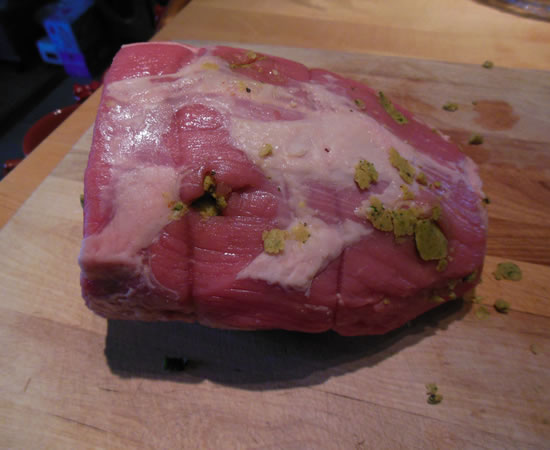
I knew when I got up this morning that it was gonna be a beef-for-dinner day. I could handle leftover turkey soup one more time for lunch, but dinner was gonna be beef.
I went perusing through past issues of La Cucina Italiana magazine and came upon a recipe that sounded extremely intriguing - wrapping a roast in parchment paper.
I decided to give it a try!
Like so many of the La Cucina recipes, the ingredients were few and the cooking style slightly unique.
The basic premise is to make a paste of lardo - a cured meat made from the layer of fat found directly under the pig's skin - garlic, parsley, and a couple other ingredients, rub it onto the roast, wrap the roast in parchment, tie it, and roast it. Not really very difficult.
Lardo-Studded Roast Beef
- 3 1/2 ounces lardo or guanciale
- 2 tsp roughly chopped flat-leaf parsley
- 1 tsp minced garlic
- 1/2 tsp black pepper
- 1 tsp paprika
- 1/2 tsp ground cinnamon
- 2 tbsp brandy
- 1 (3 1/2-pound) eye of round beef roast, excess fat trimmed
- potatoes cut into 1-inch wedges
- 4 carrots, cut into 1-inch pieces
- 4 celery stalks, cut into 1-inch pieces
- olive oil
parchment paper; kitchen string
Heat oven to 400° with racks in upper and lower thirds.
In the bowl of a food processor, combine lardo, parsley, garlic, peppercorns, paprika, cinnamon, and brandy; blend to a smooth paste.
Make about 12 x-shaped incisions about 2-inches deep all over the roast; stuff each with about 1 teaspoon paste. Rub roast all over with remaining paste and season with salt.
Roll roast in a sheet of parchment paper and fold and tuck ends under. Tie up the roast at 1-inch intervals with kitchen string. Place roast in a baking dish and cook in lower third of oven for 30 minutes.
In a roasting pan, toss potatoes, carrots and celery with oil and salt to taste.
Put vegetables in upper third of oven and continue to cook roast and vegetables until an instant-read thermometer inserted into center of roast registers 130° for medium-rare, about 45 minutes more.
Remove roast from oven (leaving vegetables in oven to finish cooking while roast rests) and let rest 15 minutes. Discard string from roast, slice roast into 1/3-inch-thick slices and serve with vegetables.
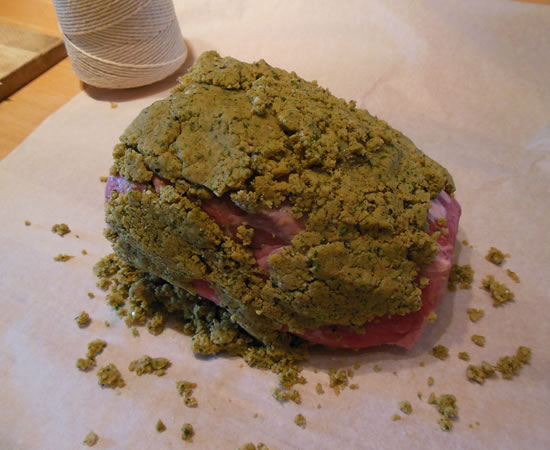
I did more pressing than spreading, but it worked. The goal is to try and cover the meat.
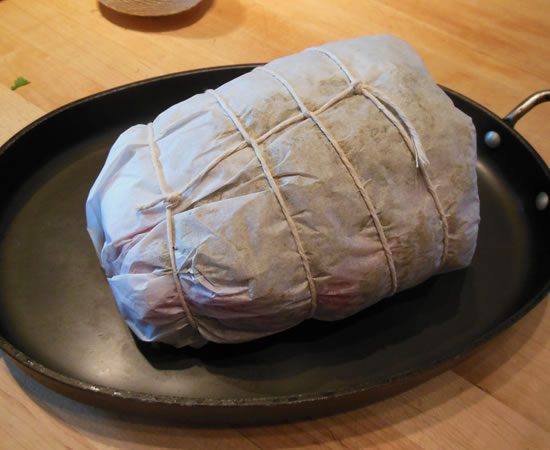
I buy full-sheet parchment paper by the case because I use so much of it. One full-sized sheet worked perfectly.

The vegetables were total simplicity.
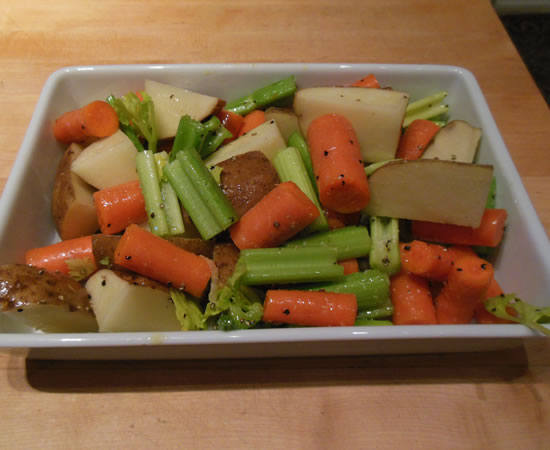
And an hour later...
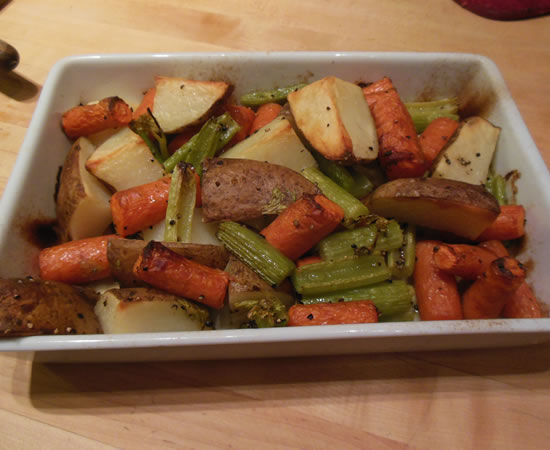
I actually over-cooked the beef for my liking, but it still was tasty.
I really should have checked it sooner, but I was relying on the clock rather than then thermometer. Next time I'll pay closer attention.
But I have to tell ya - the cooking method really rocked! The beef was juicy-tender with tons of flavor. And the whole house smelled great.
Just what I was looking for!
Butternut Squash Risotto
About 3 this afternoon, Victor asked me if I had any plans for the butternut squash that was in the 'fridge. Now, papa didn't raise no fool. It matters not if I had plans for it - if he's asking, that means he's thinking about cooking. I had no plans for it.
It was definitely the correct answer, because I got to sit down to a fabulous Butternut Squash Risotto!
We had a bit of roasted butternut squash left over from the other night - that Victor roasted with maple syrup - and that was mashed into the risotto while he roasted more - with maple syrup - that went into the risotto - with more for the top.
Yumlicious.
It was properly cheesy with the rice cooked to perfection. The butternut squash was rich and flavorful and added a second layer of creamy goodness.
Did I mention that it rocked?!?
Butternut Squash Risotto
- 1 small butternut squash, peeled and cubed
- 1 clove garlic, minced
- 1 cup risotto rice (arborio, carnaroli, vialone nano)
- 1 cup shredded parmesan cheese
- 5 cups hot chicken broth
- salt and pepper
Coat cubed squash with maple syrup and sprinkle with salt and pepper. Place on sheet-pan in 425° oven for about 25 minutes. Set aside.
Saute garlic in a bit of olive oil and butter in a risotto-style pan. Add 1 cup rice and continue sauteing until rice is slightly translucent.
Add 1 cup broth and stir until most of broth is absorbed. Continue stirring and adding broth until about 3/4 has been added.
Add roasted butternut squash, mashing some with spoon as you stir and holding some back for the top.
Continue adding broth until rice is tender.
Stir in parmesan cheese and taste for seasoning, adding more salt and pepper, if necessary.
Top with remaining squash and slivers of cheese.
Yumlicious.
Pasta Bake
I just love coming home from work and finding Victor in the kitchen! Since I had to work late, Victor said he would take care of dinner - and after 17 years and 352 days, I still marvel at what a great cook he is. This was a throw-together, clean-out-the-'fridge dish that had me going back for more.
It was pasta and meat sauce with roasted butternut squash and fresh mozzarella. And under all that were two boneless pork chops that were fall-apart tender.
It rocked.
No big recipe secret. It was like a standard baked ziti with chunks of fresh mozzarella and roasted squash added for fun. I almost had it for dinner again, tonight, but decided it would make a couple of great lunches, instead.
We both pretty much work under the same premise - if you put things together that you like, it's bound to come out good.
And it did.
Manicotti and Mamma
When there's an 86 year old in the house, mealtimes tend to be pushed forward a bit. It's not horrible on a day like this since we'll probably all be in bed early, anyway, if the lights go out, as expected.
This storm has been a pain already - and it really hasn't even hit us, yet. We're still several hours away from that.
So... we eat. Eating does make the waiting so much easier. In between bread baking and coconut bar baking, I made some sauce. Just a basic onions, garlic, peppers, mushrooms, tomatoes, red wine, and ground beef. Some Italian seasoning. Nothing overly fancy. I let it simmer for a couple of hours. The manicotti came from the freezer - as did the hot Italian sausage that I simmered in the sauce.
It went into the still-working oven for 40 minutes.
Our house is actually pretty sound-proof and we haven't heard much of the storm all day - periods when it picked up, but nothing deafening. We're definitely starting to hear it, now.
To paraphrase Bette Davis, we're in for a bumpy night.....
But bumpy, or not, we'll still eat well.
Stuffed Veal Scaloppini
Two years ago we were newlyweds in New Hampshire. We had just been married by our dear friend, Marlene. Dorrie, Jordan, Ruth, and Dave made it up for the festivities, and we ended up at an Irish pub for our mini-reception. It was pretty low-key. A bit unusual for us, I know, but after having to cancel our marriage in San Francisco because of Prop 8, we thought low-key was probably better.
It was a fabulous day with fabulous friends and a day we will never forget. It's also not the day we will be celebrating as our anniversary - that will continue to be November 23rd.
But officially celebrating or not, I still have to acknowledge it - and what better way than with a fun new dinner?!?
I had a bit of veal in the freezer and La Cucina Italiana came through, yet again.
I have to admit I was a bit skeptical of the recipe, because I don't always have the best luck keeping things contained inside breading, but this came out great!
It also wasn't that difficult, although it did make for a lot of dirty pots and pans.
Oh well... It was worth it!
Stuffed Veal Scaloppini
adapted from La Cucina Italiana
Ingredients
- 4 tbsp unsalted butter at room temperature
- 1/3 cup all-purpose flour
- 1 cup whole milk
- 2 ounces prosciutto, diced
- 2 tablespoons freshly grated Parmigiano-Reggiano
- Salt and freshly ground pepper
- 12 oz veal scallops
- 3 tablespoons extra-virgin olive oil
- 3 eggs, beaten
- 1½ cups dried bread crumbs
- Canola oil for frying
Instructions
Prepare the filling: In a small bowl, combine the butter and flour. Knead together to form a paste. Warm the milk in a small saucepan, and add the butter-flour mixture. Whisk to avoid any lumps, and simmer, stirring often, until thick, about 6 minutes. Remove from the heat, and transfer to a bowl. Add the prosciutto and Parmigiano, and mix well. Season with salt and pepper, and set aside to cool.
In a large nonstick skillet over medium heat, heat the olive oil. Season the veal scallops with salt and pepper, dredge in flour, and shake off any excess. Add the veal to the skillet, and sauté for 30 seconds on each side. Remove from the skillet, and set aside to cool.
Spread a layer of the filling over each veal cutlet. Place the veal in the refrigerator for 30 minutes or until the filling is firm.
Remove the veal from the refrigerator, and dredge both sides in flour. Shake off the excess, and dip in the eggs. Coat the veal evenly in the bread crumbs.
In a large skillet with high sides, heat 1 inch of canola oil over medium heat. Add the breaded cutlets, filling side down, and fry until golden. Carefully flip each cutlet, and cook until golden. Drain on paper towels, and serve.
The filling firms up nicely and was very easy to bread.
What started out as small scallops continued to grow. Two of the scallops were more than enough for each plate. Leftovers!!!
The cauliflower steaks are really simple to make, as well.
Simply cut the cauliflower head straight down in about 1" slices. Place in a skillet with a bit of olive oil and brown on one side. Flip, shred a bit of parmesan cheese on top along with a pinch of salt and pepper, and place in a hot oven for about 15 minutes.
And a faux Potatoes Anna is always an easy way to do potatoes when you don't want to watch them.
Place a bit of butter in a small pan and allow to melt. Thinly-slice potato and layer in pan. Drizzle a bit more butter in the pan, cover, and cook on stove-top about 15 minutes. Flip, and continue cooking another 5 or so...
All-in-all, a fun meal. And we have Pumpkin Pie for dessert!
That's Italian!
I came home to stuffed shells and braciole. My life is so good! And so was dinner!
Saturday is often Victor's day to play in the kitchen while I'm at work, and it can either be something simple or something extraordinary. Tonight was definitely the latter!
Braciole in its most base form is merely thin-sliced beef with a bread stuffing, rolled, pan-fried, and simmered in a tomato sauce. It can be done as a large roast-sized item or small, individual pieces. I like the small ones the best.
Ya just place the meat on the counter, pound flat, if necessary, and cover with the bread crumbs mixed with a bit of grated cheese, garlic, and a bit of S&P. Roll it up jelly roll-style and secure with toothpicks.
Brown in a skillet and then place in a casserole with sauce and bake at 350° for about 30 minutes.
Stuffed shells are one of my absolute favorites! The filling is ricotta cheese, a bit of shredded mozzarella, an egg, a bit of chopped parsley, and a pinch of S&P. Simple ingredients that pack a wallop of flavor. They also baked at 350° for 30 minutes. Victor had extra bread crumbs left over so they went on top, as well.
Shells are actually pretty easy to fill. Place the filling in a ziplock bag and cut off a corner. Use it like a pastry bag.
A totally successful dinner! And to show my appreciation, I'm making a phyllo-crust pumpkin pie for dessert.
Experiments are fun.
Butternut Squash Risotto
I didn't have a plan for dinner tonight, but when I saw a big ol' display of butternut squash, an idea started forming... I know it's not quite fall, but I was really jonesin' for butternut squash. It's the perfect fall food. With an almost-chill in the air, it was time. I made a butternut squash risotto last year at this time. It was time for another.
I still have Vialone Nano rice from Italy, so that was my risotto rice of choice. It is seriously a fool-proof risotto rice. Perfect every time.
I'm thinking a butternut squash soup in the near future. Maybe Sunday on the first full day of autumn.
Butternut Squash Risotto
- 1 small butternut squash, peeled and cubed
- 1 chicken breast, chopped
- 2 chopped shallots
- 1 cup chopped mushrooms
- 2 cloves garlic, minced
- 1 cup risotto rice (arborio, carnaroli, vialone nano)
- 1 cup shredded parmesan cheese
- 6 cups hot chicken broth
- sage
- salt and pepper
Coat cubed squash with olive oil, and sprinkle with salt and pepper. Place on sheet-pan in 425° oven for about 25 minutes. Set aside.
Saute shallots in a bit of olive oil and butter in a risotto-style pan. Add chicken and brown. Add, mushrooms, and garlic. Cook until vegetables are wilted and fragrant.
Add 1 cup rice and continue sauteing until rice is slightly translucent. Add 1 cup broth and stir until most of broth is absorbed. Continue stirring and adding broth until about 3/4 has been added.
Add roasted butternut squash, mashing some with spoon as you stir.
Continue adding broth until rice is tender.
Stir in parmesan cheese and taste for seasoning, adding more salt and pepper, if necessary.
It was another hit. Creamy, rice with just the right bite to it, and enough different flavors and textures to make it interesting.
Lovin' the weather!
Cheese Tortellini with Chicken
I had a hankerin' for pasta but had taken a couple of chicken breasts out of the freezer. The only sensible thing to do in a situation like that is to take the chicken and make a nice, creamy sauce to go with the pasta.
And being the ever-sensible person that I am, that's exactly what I did!
Yes, sensibility abounds in the Dineen/Martorano household. Well... at least it does in my mind - and that's really the only thing that matters, right?!? Right.
So... donning my sensibility cap, I started out.
Into the pot went the tortellini. They take about 8 minutes to cook.
I cut up the chicken into small cubes - maybe 1/2" - and quickly sauteed them in a drizzle of olive oil. I minced a garlic clove and added that to the skillet, and then chopped a couple tablespoons of sun-dried tomatoes in oil and added them.
I then added about 3/4 cup of heavy cream and a pinch of salt and pepper. I let it boil and thicken while I drained the pasta.
I added a hefty handful of freshly-grated pecorino romano, stirred it in, and then added the tortellini.
Simplicity.
It definitely came out good. The sauce thickened nicely and the tomato and cheese - and garlic - added a nice bite.
And it took less than 15 minutes to get it on the table!
So sensible.
Corzetti with Pesto and Green Beans
The Pasta Issue from La Cucina Italiana magazine has arrived. Victor has been poring over it looking for fun things to make - last year's issue didn't really do it for him - and found quite few that he likes. We're going to be eating well! The first thing he did was send away for a corzetti stamp from Fante's. The stamps date from the Renaissance courts of Liguria in northern coastal Italy around Genoa. Coin-shaped corzetti pasta would be stamped with coats of arms and symbols representing holidays. While the stamps would show ones prominence at court, they also have a practical purpose - the textures help capture the flavors of the sauce.
The recipe for the dough is a bit different than the one he normally makes. This one called for a 1/2 cup of water. It made for a bit of a stickier dough than usual, but he made up for it with flour for rolling. Oh... and we just happen to have Italian "00" flour. If you don't, use all-purpose.
Fresh Corzetti
- 2 cups "00" flour - or all-purpose flour
- 1/8 tsp salt
- 2 large egg yolks
- 1/2 cup tepid water
Mix together flour and salt on counter. Make a well and add the yolks and water. Using your finger (or a fork) and slowly incorporate the egg, water, and flour. Use a dough scraper to gather the dough up and form into a ball. Sprinkle more flour on the board and knead the dough until it is smooth - about 5 minutes. Cover dough and let rest about 30 minutes. This is actually an important step. During the resting period, starch molecules in the flour are absorbing the liquid in the dough. This gives the dough a thicker, more viscous consistency. The gluten is also relaxing which helps create a thin and uniform structure to the dough. And because the gluten had time to relax, the texture is delicate instead of chewy.
Divide dough into 4 pieces. Roll pasta through machine starting at widest setting about 4 times, folding and turning dough each time, until it is smooth and the width of the machine. Continue feeding dough though machine, decreasing the setting one notch each time, until about 1 1/2 millimeters thick - Victor went to setting three.
Dust pasta with flour and then, using corzetti cutter, cut out rounds. When rounds are cut, use the corzetti stamp to stamp each coin individually.
Cook pasta in boiling water about 6-7 minutes. Drain and immediately mix with sauce.
The pasta was time-consuming to make, but - WOW - what a great flavor and texture! Looking at the size, they should have been heavy - but they were really light with a good tooth and great texture.
The magazine recipe called for a sauce with scallops. Victor decided we had so much basil we needed a pesto sauce, instead. Naturally, he was right!
Pesto with Sun Dried Tomatoes
- 1 cup pine nuts
- 4 cups basil leaves
- 3 garlic cloves
- 1/2 cup grated pecorino romano cheese
- 1/4 cup sun dried tomatoes in oil
- 1/2 cup olive oil
- S&P to taste
Toast pine nuts. Cool. Add basil, pine nuts, and garlic to food processor. Mix a bit and then add cheese, sun dried tomatoes, and a pinch of salt and pepper. Mix well. With machine running, slowly add olive oil. Check for seasonings and ad S&P, as desired.
To pull the dish together...
Cook pasta and drain. Cook green beans until barely done. (Cook with the pasta and save a pot.) Add pesto to skillet. Add pasta and green beans, along with a bit of pasta cooking water, and gently mix.
Serve with additional grated cheese and chopped fresh tomatoes.
This rocked on every level! The pasta was substantial but surprisingly light. The sauce just screamed fresh-from-the-garden-goodness. We not only cleaned our plates, but really cleaned them with slices of Italian bread to get every drop of sauce. They were almost clean enough to put back in the cupboard!
This one is a keeper.

